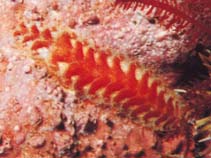Harmothoe imbricata (Linnaeus, 1769)
Fifteen-scaled worm
Classification / Names Common names | Synonyms | CoL | ITIS | WoRMS
| Phyllodocida | Polynoidae
Environment: milieu / climate zone / depth range / distribution range Ecologia
; distribuzione batimetrica 0 - 230 m (Ref. 116516). Tropical; 78°N - 25°S, 180°W - 180°E
Distribuzione Stati | Aree FAO | Ecosystems | Presenze | Introduzioni
Indo-Pacific, Atlantic Ocean, Arctic and the Mediterranean Sea. Tropical to polar.
Length at first maturity / Size / Peso / Age
Maturity: Lm ? range ? - ? cm
Motile carnivore that uses a jawed pharynx for feeding (Ref. 125928).
Life cycle and mating behavior Maturità | Riproduzione | Deposizione | Uova | Fecundity | Larve
Members of the class Polychaeta are mostly gonochoric (sexual). Mating: Females produce a pheromone attracting and signalling the males to shed sperm which in turn stimulates females to shed eggs, this behavior is known as swarming. Gametes are spawned through the metanephridia or body wall rupturing (termed as "epitoky", wherein a pelagic, reproductive individual, "epitoke", is formed from a benthic, nonreproductive individual, "atoke"). After fertilization, most eggs become planktonic; although some are retained in the worm tubes or burrowed in jelly masses attached to the tubes (egg brooders). Life Cycle: Eggs develop into trocophore larva, which later metamorph into juvenile stage (body lengthened), and later develop into adults.
Main reference
Bibliografia | Coordinatore | Collaboratori
Salazar-Vallejo, S.I. and M.H. Londoño-Mesa. 2004. (Ref. 8159)
IUCN Red List Status (Ref. 130435)
CITES status (Ref. 108899)
Not Evaluated
CMS (Ref. 116361)
Not Evaluated
Threat to humans
Human uses
| FishSource |
Strumenti
Informazioni ulteriori
Fonti Internet
BHL | BOLD Systems | CISTI | DiscoverLife | FAO(Publication : search) | Fishipedia | GenBank (genome, nucleotide) | GloBI | Gomexsi | Google Books | Google Scholar | Google | PubMed | Tree of Life | Wikipedia (Go, ricerca) | Zoological Record
Estimates based on models
Price category
(Ref. 80766):
Unknown.



